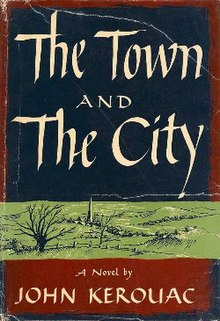
Back البلدة والمدينة Arabic Maloměsto, velkoměsto Czech The Town and the City Danish The Town and the City German Avant la route French La città e la metropoli Italian
 First edition | |
| Author | Jack Kerouac |
|---|---|
| Language | English |
| Genre | Semi-autobiographical novel |
| Publisher | Harcourt Brace |
Publication date | February 1950 |
| Publication place | United States |
| Media type | Print (Hardback & Paperback) |
| Pages | 499 |
| OCLC | 9489071 |
| 813/.54 19 | |
| LC Class | PS3521.E735 T6 1978 |
| Followed by | On the Road (1957) |
The Town and the City is a novel by Jack Kerouac, published by Harcourt Brace in 1950. This was the first major work published by Kerouac, who later became famous for his second novel On the Road (1957). Like all of Jack Kerouac's major works, The Town and the City is essentially an autobiographical novel, though less directly so than most of his other works. The Town and the City was written in a conventional manner over a period of years, and much more novelistic license was taken with this work than after Kerouac's adoption of quickly written "spontaneous prose". The Town and the City was written before Kerouac had developed his own style, and it is heavily influenced by Thomas Wolfe (even down to the title, reminiscent of Wolfe titles such as The Web and the Rock).
The novel is focused on two locations (as suggested by the title): one, the early Beat Generation circle of New York in the late 1940s, the other, the nearly rural small town of Galloway, Massachusetts, that the main character comes from, before going off to college on a football scholarship. Galloway represents the city of Lowell, Massachusetts, which the Merrimack river runs through, and where Kerouac was raised. The experiences of the young "Peter Martin" struggling for success on the high school football team are largely those of Jack Kerouac (he returns to the subject again in his last work Vanity of Duluoz, published in 1968).
The "city" represents a number of figures of the early beat circle: Allen Ginsberg (as Leon Levinsky), Lucien Carr (as Kenneth Wood), William Burroughs (as Will Dennison), Herbert Huncke (as Junky), David Kammerer (as Waldo Meister), Edie Parker (as Judie Smith) and also Joan Vollmer (as Mary Dennison) – though she essentially has a non-speaking role (however some of her ideas are quoted by the Ginsberg-figure). Near the end of the novel, the Waldo Meister character dies by falling from the window of Kenneth Wood's apartment (a distant echo of the real event: David Kammerer knifed by Lucien Carr, possibly in self-defense). In the novel the police largely just accept this as a suicide. A version of the events closer to the truth can be found in Vanity of Duluoz, in which Carr was arrested and eventually accepted a plea of manslaughter and a prison sentence; and Kerouac was arrested and held briefly as an accessory after the fact. Still another version of the story can be found in an early novel Kerouac collaborated on with William S. Burroughs, And the Hippos Were Boiled in Their Tanks, published after Kerouac's death.